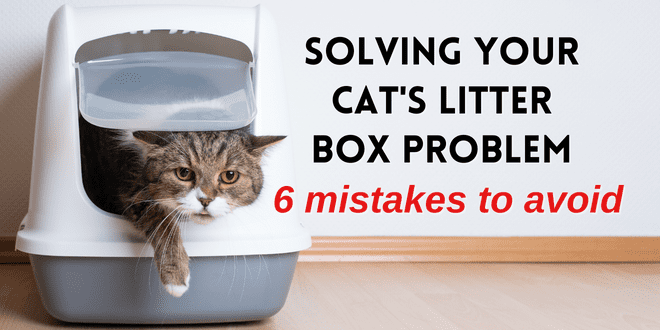
It can be extremely frustrating when your cat stops using the litter box. Anything and everything in your home can become a potential target of urine or feces. Litter box aversion is the most common problem clients call me about and in many cases, those clients are at the end of their ropes. Cat parents seem to be able to tolerate furniture scratching, biting or constant meowing but when a cat pees on the carpet day after day it can be a deal-breaker. Nothing sends a cat to the shelter faster than a house that smells like cat pee.
Sadly, many of the cats relinquished to shelters, abandoned, or euthanized due to litter box problems could’ve been helped. Litter box problems cause cat parents to react impulsively, emotionally, and sometimes irrationally. The sight or smell of cat pee on a cherished sofa or an expensive carpet can easily short-circuit a person’s patience. The level of frustration is understandable but how people handle the problem can either improve the situation or send it on a downward spiral. Here are some harmful mistakes I’ve seen cat parents make:
1. Waiting Too Long to do Something About it
I can’t tell you how many times people call me and request an immediate consultation because they’re planning on taking the cat to the shelter within days. The problem has usually been going on for weeks, months, and maybe even years and then the cat parent reaches the breaking point. The longer a problem goes on, the harder it is to correct. If you wait until the problem has caused you to reach your breaking point then you probably won’t be in a good frame of mind to do the proper behavior modification. It’s also extremely unfair to the cat. When a cat feels unable to use the litter box for whatever reason, it’s stressful. If the reason is medically related, it also causes suffering. Don’t wait.
2. Assuming the Problem is Behavioral
Many behavior problems have underlying medical causes. Many cats suffer in pain because a cat parent assumes the cause of the litter box aversion is due to a behavior problem when in fact, it might be due to a urinary issue, renal failure, diabetes, or any number of medical issues. For older cats, it may be difficult to get to the box because of arthritis or other age-related problem. Whenever a cat displays a change in behavior then a veterinary exam is needed. Once the veterinarian determines the cat doesn’t have an underlying medical problem then you can tackle this from a behavioral standpoint.
It’s not unusual for many cat parents to assume the cat is peeing on the bed or the carpet out of spite but that kind of thinking will prevent success when it comes to correcting the problem. Cats don’t do things out of spite or because they’re angry at you. Cat parents who think that way will overlook the need for a veterinary check-up and could cause the cat to suffer needlessly. Also, that kind of thinking sets you up for total failure in terms of trying to solve the problem.
3. Punishment
This is so counter-productive it’s heartbreaking. Rubbing your cat’s nose in their mess, spanking, yelling, time-out, squirting her with water, or any other form of punishment does nothing to help retrain and in fact, can make the situation worse. If your cat is peeing outside of the litter box, it’s being done because the cat feels there’s no other option.
If you punish your cat for it you add stress, potentially creating an added fear of you in the process, and kitty may start retaining urine (which is medically harmful) for as long as she can out of fear of being punished. Hitting a cat is also inhumane and harmful to the behavior process. Your hands should never be used as weapons. How can you ever expect your cat to trust you if she doesn’t know whether the hand coming near is going to pet or smack? Fear, intimidation, and pain are not appropriate behavior training tools. Don’t let your frustration over a behavior problem get the best of you because your relationship with your cat will suffer.
Behavior also has a purpose. It doesn’t mean you will like the behavior, but it’s important to understand that cats display behaviors because they work.
4. Not Finding the True Cause
Animals don’t repeat behaviors unless they serve a function. If your cat eliminates outside of the litter box there’s a valid reason for it. The reason is certainly not an acceptable one from the cat parent’s point of view but the cat is trying to solve a problem in the best way she knows how. Let’s look at a couple of examples: Perhaps the cat is eliminating outside of the box because it’s too dirty. While you may think scooping the box once every day or so is adequate, your cat may not feel it’s clean enough. Your cat may eliminate in other areas of the house because those locations are cleaner. Maybe kitty is peeing in the dining room because every time she tries to go into the litter box she gets ambushed by a companion cat. Perhaps the dining room offers more escape potential because the cat can see an opponent approaching from a distance and has more places to run. Avoidance of the litter box may be due to the fact that the cat has a physical problem and can’t get into the box anymore, or maybe she can’t go up and down the stairs in time when the bladder is full.
You may have set up a litter box that’s very private but in the cat’s mind the privacy limits the ability to feel safe. Another example may be that the box is located in an unappealing location. Perhaps it’s in a basement where the cat gets blocked by another cat on the stairway. In a multicat household, the problem may be that there aren’t enough litter boxes. There are numerous other reasons your cat may feel it’s necessary to choose an alternate location to the litter box. If you just set up deterrents without getting to the source of the problem the cat just keep looking for other locations. Whether the cause is behavioral or medical, it’s your job to find the reason. In CatWise you can find detailed information about understanding and correcting litter box problems but if you still feel as if the problem is too complex, talk to your veterinarian about a referral to a veterinary behaviorist or certified cat behavior consultant.
5. Being Inconsistent
Cats like predictability and they take comfort in knowing things in their environment aren’t going to change on a daily basis. Whether it’s your desire to switch to a different brand of litter, the fact that you love rearranging the furniture, or the irresistible urge to buy the cat food that’s on sale this week, sudden change is upsetting to cats. I had a client once who couldn’t decide where he wanted the litter box located in his house so he moved it every day as an experiment. The experiment ended in disaster because his cat couldn’t possibly keep up with the ongoing disappearing act and it resulted in a huge amount of stress (and soiled carpet). Introduce changes in your cat’s life in a gradual way. If you want to switch litter brands do it slowly by adding a little of the new litter into the current brand and then increasing the amount over the course of a few days. When introducing a second cat into the household do it gradually so both cats get a chance to adjust. Cats don’t want to be taken by surprise.
6. Giving Up
Don’t give up on your cat. Too many cats end up in shelters or get banished to the outdoors for litter box problems that could’ve been resolved. If you feel as if the problem is more than you can handle, ask your veterinarian for a referral to a certified behavior expert. In many cases, the solution to the problem may actually be easier than you think. Your cat is a member of the family and deserves getting the help needed to solve this issue.
Need More Help?
You can find more in-depth information on litter box issues in the best-selling books by Pam Johnson-Bennett. Pam’s books are available at bookstores and online. We’ve included Amazon links here on our website.
If you have a question about your cat’s behavior or health, contact your veterinarian. This article is not intended as a medical diagnosis nor is it a replacement for your cat’s regular veterinary care. This article is for general information purposes only.





